Pide is the famous baked Turkish flat bread that comes stuffed with a variety of toppings, including cheese, sausage, spiced meat and spinach. Often described as a Turkish pizza, the greasy, gut-busting takeaway Pides sold at neon-lit corner kebab shops have long been my secret food shame. But shame no more: this delicious homemade Pide recipe trumps takeaway 10 times over – and then some!
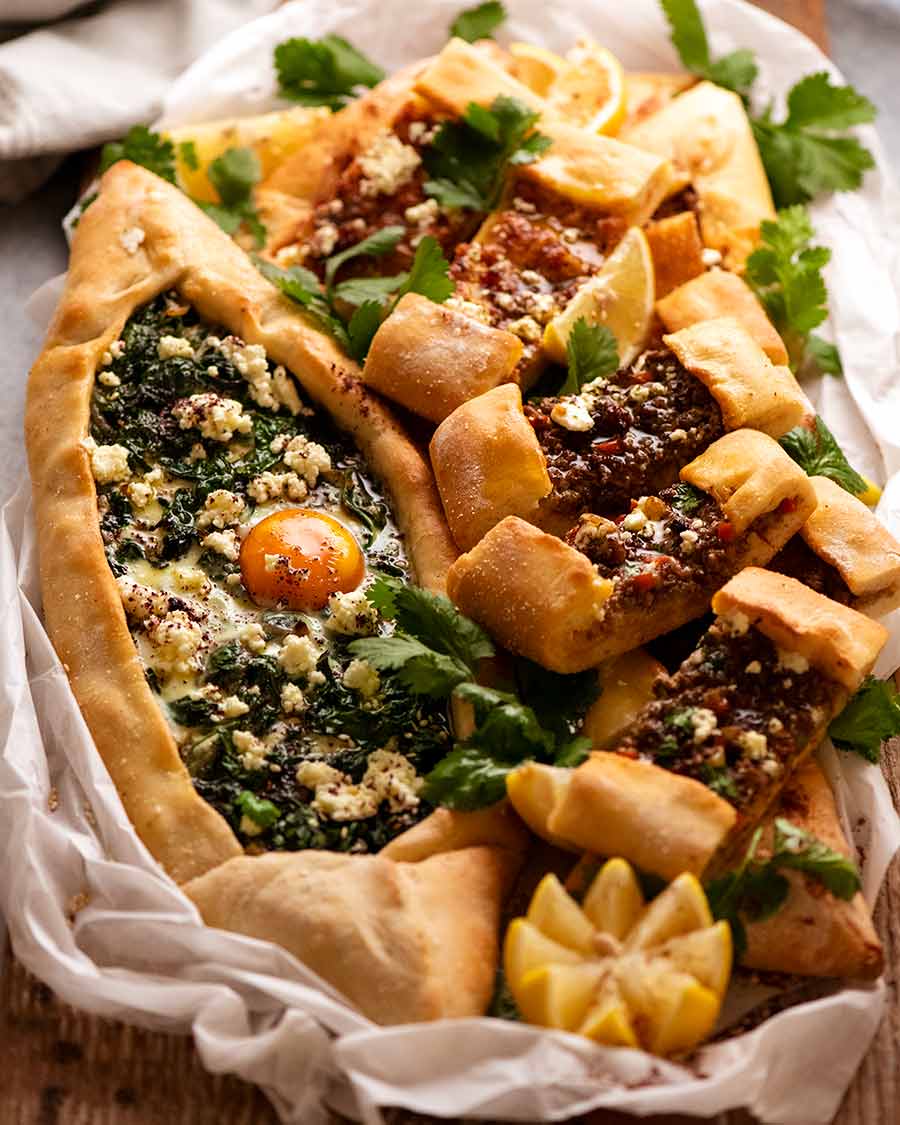
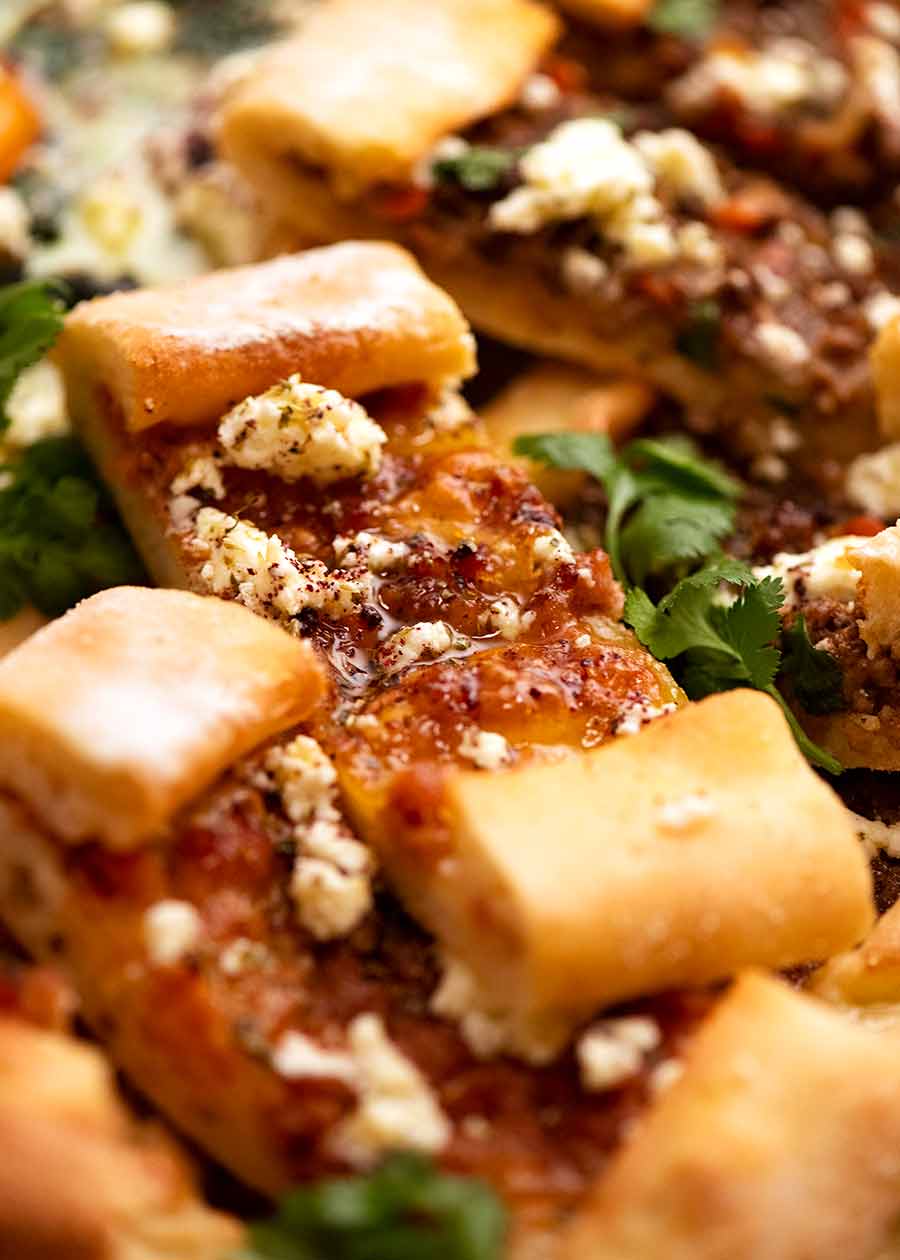
Pide
Turkish Pide has been my Secret Food Shame* for as long as I can remember. Not authentic, freshly made Pide crafted lovingly by the hands of someone’s Turkish grandma. I’m talking about the greasy, low-rent versions sold from hot glass cabinets at late night takeaway shops, filled with cheap cheese and piles of meat shaved from giant Doner Kebab punching bags turning lazily on vertical rotisseries.
It’s a bit wrong, I know, but I cannot help myself. I have always had a soft spot for bad takeaway Pide. What can I say? When you’re nursing battle wounds from a bad week at work, cheese + bread + tasty toppings will do it every every time!
But like all things, there’s a time and place. Pide can be trash food but it can also be incredible, going toe-to-toe with the best artisan Italian pizzas. Made totally from scratch like today’s recipe, it’s apples and oranges to the takeaway junk – even a chronic takeaway Pide tragic like me will admit it!
* Food you secretly love but are ashamed to be caught eating. Think: McDonald’s drive-through. The Dirty Bird (aka KFC). Panda Express. Instant mac and cheese. We are all guilty!

What is Pide, actually?
Originating from Turkey, Pide is an oval-shaped flatbread baked with various combinations of toppings or stuffings. You could say it’s a cousin of Gozleme, only Pide dough is fluffier and more bread-like. Spiced mince meat (Kiymali Pide) is common, as are versions with spinach, and also Turkish beef sausage (sujuk).
Pronounced pee-dae, Pide is typically open-faced, though sometimes you also see closed versions. With the latter, the filling is completely sealed within the bread. While both are delicious, the extra flavour you get from the toppings sizzling away in the oven is irresistible to me, so that’s the version I’ve opted for today!
Traditionally, Pide is cooked in a stone oven, but this recipe today is for a boring old home oven. 🙂 We will survive!
How to make Turkish Pide
In this section, I’m going to step through how to make Pide, from the dough through to assembly and baking. I’ll also cover how to make each of the topping variations. A content summary:
Pide dough
Making the dough
Assembling the pide
Three topping variations:
About Kasar Turkish cheese (substitute mozzarella)
#1: Spinach topping
#2: Turkish sausage (sujuk / sujuk)
#3: Spiced lamb (Kiymali Pide)
The sprinkled finishes for Pide
Heads up!: This section is quite long because I walk through each step, including the ingredients for the three topping options. My goal is to provide enough information so even those of you who are not experienced using yeast are armed with all the information you need to make this. You’ve got this! I promise!
(If you’re an old hand at all things baking and don’t need this level of information, just skip to the recipe or recipe video!)

Spiced Lamb Topping 
Spinach Pide 
Turkish Sausage
1. Pide dough
Pide dough ingredients
Here’s what goes in the Pide dough:
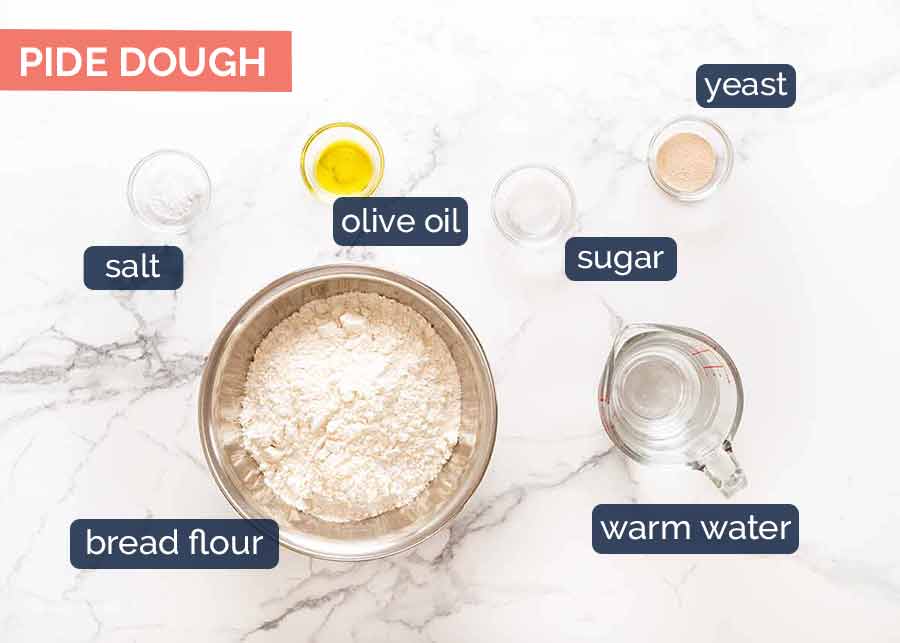
Flour – Bread flour produces a slightly fluffier, softer bread than using plain / all-purpose flour. It also has a slightly better chew, a key characteristic that distinguishes bread from, say, cake which has a tender, crumbly crumb by contrast.
The difference between bread flour and plain flour however is actually quite marginal, so I’m not going to insist on it as strongly as I do in other recipes where using bread flour really makes a difference (eg. like, say, in our favourite Crusty Artisan Bread). So for this recipe, I recommend using bread flour only if you have it. If you don’t, I wouldn’t make a special trip to the supermarket because this is excellent made with all-purpose / plain flour too;
Yeast – Instant / rapid-rise yeast is called for here. The recipe also works with standard active / dry yeast, but we discovered during the naan recipe project (or odyssey rather!) that flatbreads are slightly fluffier and softer using instant yeast;
Sugar – The yeast feeds on sugar to activate, bloom and do its yeasty thing. Without sugar, the mixture won’t become foamy nor will the dough rise as much; and
Warm water – The other things yeast needs to get it alive and kicking. You do not want scorching hot water as this will kill the yeast. Nor do you want too cold, as this slows the yeast activation significantly, and the mixture will never become foamy which means the dough won’t rise. Blood temperature is about right.
How to make Pide Dough
BLOOM THE YEAST
First step: Let’s get the yeast activated and ready to work its magic on our dough.

Mix instant yeast with warm water and sugar – Once mixed, leave it for 10 minutes to bloom, ie. become foamy. This is not a typical step you see in bread-making when using instant yeast. Usually the whole point of instant yeast is that you can add it straight into dough without mixing with warm water and letting it foam first.
But when creating my naan recipe, we found that blooming instant yeast in a warm water and sugar solution first makes flatbreads fluffier and softer. It’s also an excellent safety test to ensure your yeast is still alive. Foamy yeast in water = alive, no foam = dead yeast! That’s right, dried yeast stored in a jar eventually dies (that’s what the expiry means – but actually it starts to degrade well before that). Nothing is worse than discovering your yeast is dead by taking out a cooked bread loaf from the oven that’s rock hard and flat!
Foam test – So we do our yeast foam test to avoid all this potential heartbreak. This is what it looks like after 10 minutes. Foamy, good!
MAKE THE DOUGH
The dough can be made either by hand or using a stand mixer.

Mix ingredients – Mix the flour and salt together. Then mix in the yeast mixture, olive oil and remaining warm water. Start off by stirring with a wooden spoon or spatula, but once the flour is incorporated you will find it too stiff to stir. At this point, switch to your hands and start kneading;
Knead 10 minutes – If you’ve got the arm muscles and enjoy the kneading process, you can knead the old-school way by hand on a lightly floured surface. It will take about 8 to 10 minutes to make the dough transform from rough and tight to smooth and elastic (see Step 6 above for before-and-after visuals);
Stand mixer option – Alternatively, if you’ve got a stand mixer, let it do the hard work for you. 3 minutes on speed 6 is all the takes;
How to tell the dough is kneaded enough – Hold the dough in your hands then pull the sides down to stretch the surface. If the surface breaks and is bumpy (like pictured on the left in photo #6), then the dough is not yet ready. If the dough surface is smooth, stretches apart and does not break, then it’s ready!
RISE DOUGH 1 TO 1.5 HOURS – LET IT DOUBLE IN SIZE

Proof dough – Once the dough has been kneaded, shape it into a ball. Lightly grease the insides of the used bowl, and place the dough inside. Smear the dough surface with oil. This is to stop anything from sticking to the surface as it rises (eg. if the cling wrap sags).
Cover with cling wrap and put the bowl somewhere warm to let it proof – about 1 – 1.5 hours, until it has doubled in volume.
When seeking a warm place to let the dough rise, remember that the warmer it is, the faster it will rise. Do not put it in direct sunlight, it’s too strong and will dry out the dough. CHEEKY TIP: Use your dryer! Run it for a few minutes to warm it up, then place the dough in and close the door. It’s a draught-free, warm and cosy environment your dough will love!
Doubled in volume – The dough pictured above is after proofing for 1 hour, and is just over double in size. It’s ok if it more than doubles, but if the dough rises too much (as in, more than triple), then the yeast can run out of oomph and not rise properly when cooked. Try to limit proofing to doubling in size!
Rise #2
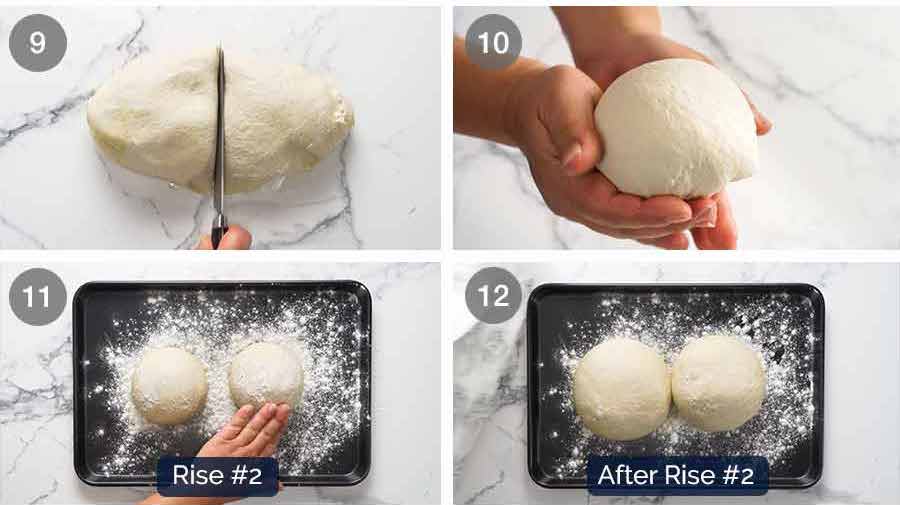
Deflate and halve – Once the dough has doubled in size, punch it down to deflate completely. Turn it out on to a work surface then cut into two equal pieces;
Shape into ball – Pull down the sides of the dough to stretch the surface so it’s nice and smooth, gathering the dough on the underside of the ball. Then shape it into a neat sphere;
Rise again for 15 minutes, 50% increase in size – Place the balls on a lightly floured tray (smooth ball surface up), and cover with a tea towel. Leave to rise in a warm place for 15 minutes until they increase in size by about 50%. It usually doesn’t take as long as the first rise;
After rising – Photo #12 is what they look like after 15 minutes. Ready to roll out and cook!
Assembling and baking the Pide
Dough done, now it’s time to assemble! I walk through the making of each of the toppings further below.
Roll out the dough

Roll out – Take a piece of dough and place it on a lightly floured surface. Then roll it out into a 40 x 20cm (16 x 8″) oval shape that is around 20cm / 8″ wide at the widest point;
Semolina under the base (optional) – Store-bought Pide often has some semolina sprinkled under the base. The tiny ball bearing-like grains serves a double purpose of making sure the Pide doesn’t stick to the tray, as well as providing a touch of extra crunch. It’s only on the base, not on the folded sides.
To replicate this, sprinkle a bit of semolina on the tray, covering an area 40 x 15cm (16 x 6″) which is the approximate footprint of the Pide. Then transfer the rolled out dough on to the tray, covering the semolina.
Transferring the dough: The dough is sturdy enough to pick up with your hands. Out of habit, in the recipe video you will see me roll it around a rolling pin then unroll it onto the tray (I do this with more fragile pastries like shortcrust and sweet tart crusts);
Assembling the Pide
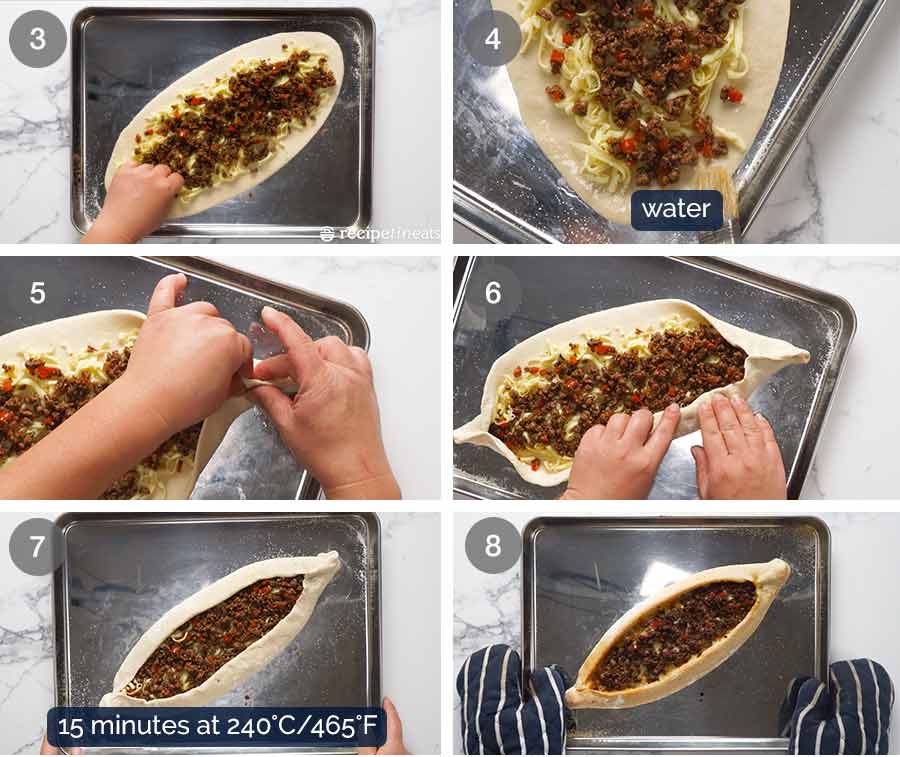
Topping – Sprinkle the pide with cheese then your topping combo of choice (spinach, Turkish sausage and spiced lamb are the three filling options I’m providing today). Leave a 2cm (4/5″) border all around for folding the sides in;
Brush ends with water – Brush the pointy ends with water to help the dough ends stick together when you seal the Pide;
Pinch ends together to seal, crimping one edge slightly over the other if needed to make it hold;
Fold sides in – then fold the sides in, pressing a crease in the dough as needed to make it stay in place;
Bake for 15 minutes at 240° / 465°F (220°C fan). This hot oven will give the bread some nice colour and beautiful caramelisation on the surface of the toppings, which the lamb mince and Turkish sausage options really benefit from;
Voila! Done! The bread should have some nice golden colour on it. The base will be nice and crispy while the inside of the bread will be deliciously soft and fluffy.
Finally, sprinkle with finishes / garnishes of choice (see below). Devour while hot!

Here’s a close up photo of inside the bread. You can see how there’s nice large irregular size holes, a clear sign of how fluffy this bread is. Just because it’s a flatbread, that’s no excuse for dense bread!!

TOPPINGS
OK! Pide basics covered, now moving on to the topping details. We’re on the home stretch here, friends!
1. Cheese for Pide: Turkish kasar
Let’s start with the cheese – because cheese always matters! 😂
The traditional cheese used for Pide is called kasar and it’s a Turkish cheese made from sheep’s milk sometimes mixed with a bit of goat’s milk. It has a similar taste, texture and melting qualities of for example, mozzarella. So if you can’t find it, use mozzarella instead.
This is what it looks like. This was purchased from a Turkish grocery store called Gima Supermarket in Auburn (Sydney).

Kasar Turkish Cheese for PIde 
2. Spinach Pide
Let’s kick off with the easiest topping: spinach!

To prepare the spinach topping, simply sauté the onion then add the spinach to wilt it. Finally mix in some subtle flavourings (cumin, salt, pepper).
Let the spinach filling cool before using so it doesn’t make the dough wet from the spinach steam, and so the Pide rises better.

The Spinach Pide below is finished with tulum cheese (more on this below, substitute with feta) and a sprinkle of sumac for a fresh, lemony flavour.
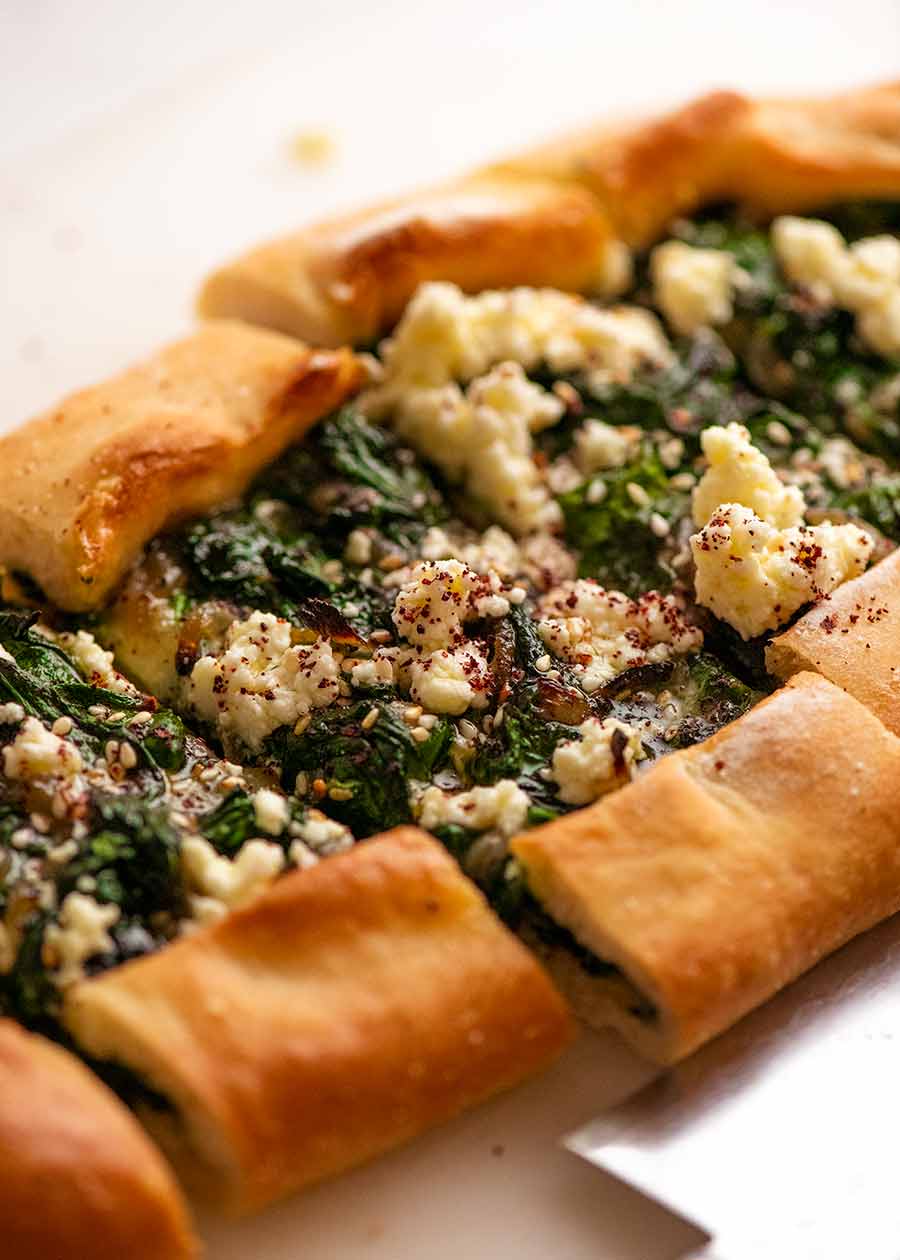
3. Turkish sausage (sujuk or sucuk)
Sujuk is a spiced Turkish beef sausage with intense garlic, cumin, sumac and herb flavours. It is semi-cured and has a softer texture than, say, salami and is sold refrigerated.
The best substitute is chorizo, which has similar cooking qualities and fattiness. Though it doesn’t have quite the same flavour profile (chorizo has strong garlic and paprika / pimentòn seasonings), it has very similar intensity of flavour and importantly, fattiness.
The other thing just to note is that chorizo is made from pork so it’s not used in Turkey, which has a predominantly Muslim population.
Note: I used chorizo in the recipe video because I ran out of sujuk!
If you are keen to experience the real thing, you can find sujuk at Turkish and some Eastern European / Continental grocery stores. The sausage pictured below is from the Turkish Gima Supermarket in Auburn (Sydney).
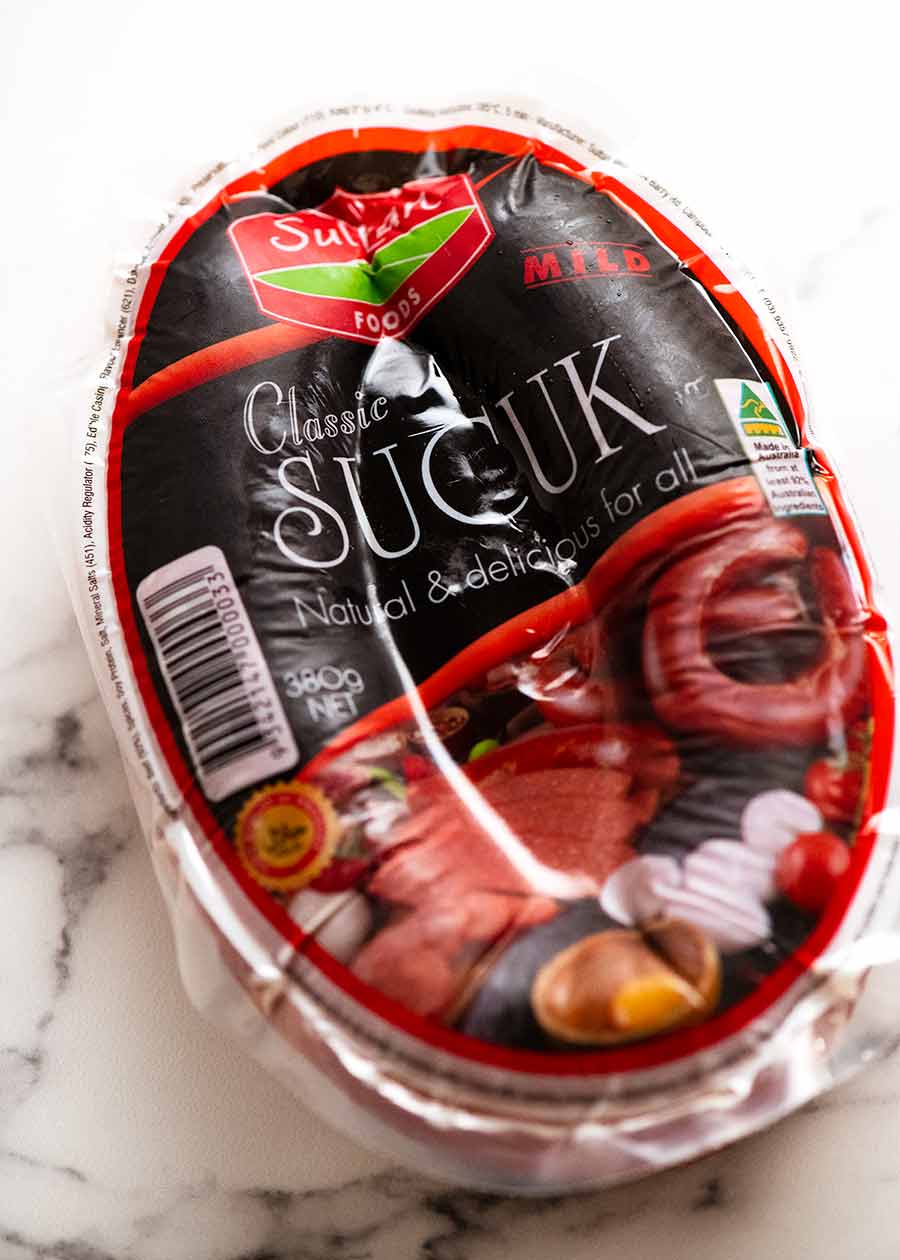
Turkish Sausage for Pide – called “Sujuk” or “Sucuk” 
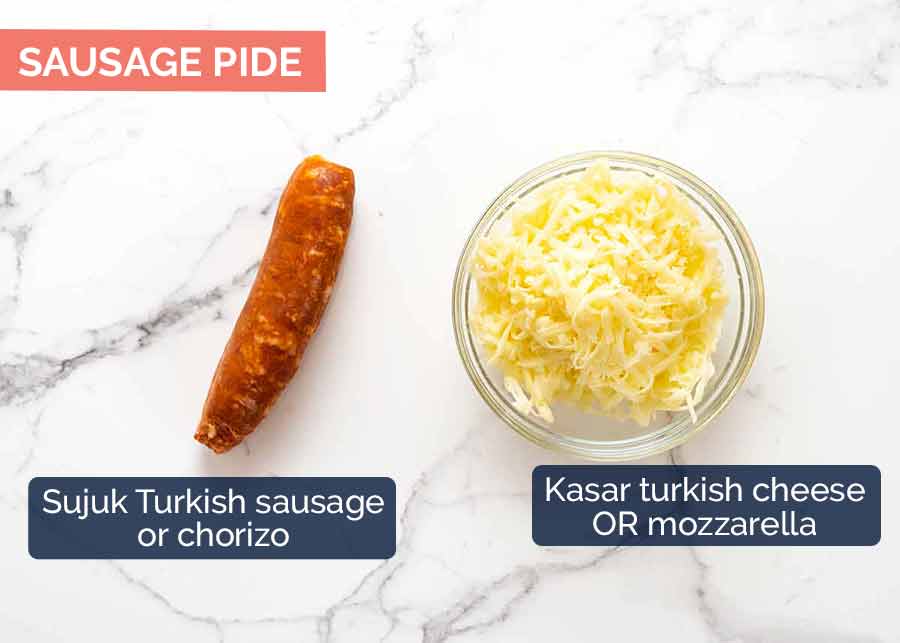
To prepare the Turkish sausage, chop it roughly then blitz to mince it up so it can be scattered across the pide. The effect of blitzing is twofold – for better coverage of the sausage across the surface of the pide, and also to release flavour. It’s so much tastier than just scattering the pide with chopped sausage! However if you prefer, you can just dice finely or slice.

The sprinkling finishes I chose to for the Turkish Sausage Pide (err, well, Chorizo Pide in this photo!) are Turkish tulum cheese (substitute feta) and oregano.

4. Lamb Pide (Kiymali Pide)
And here’s what goes into the spiced lamb topping:

Some notes on a few of these ingredients:
Lamb – The mince can be substituted with beef mince, but lamb is more traditional;
Baharat spice mix – Baharat is a Middle Eastern spice mix that can be purchased ready-made, or you can make your own. Recipes vary but the one I buy has paprika, cumin, coriander, cinnamon, nutmeg, cloves, cardamom. I bought mine from Harris Farm Market in Sydney. It’s also carried by Middle Eastern and some Continental grocery stores, and spice shops. Aussies: Heads up! The spice mix sold by Woolworths labelled “Baharat” isn’t the right flavouring! I don’t recommend it.
For the making part, there’s nothing tricky here. Sauté the onions, cook off the mince, then add everything else and cook it down until all the juices from the tomato evaporates. We don’t want the lamb filling to be wet otherwise it will tend to make the bread soggy.


For the Lamb Pide, I garnished with sesame seeds and fresh coriander / cilantro. The bright green from the herb breaks up the sea of browns nicely, I think. 🙂 I also sprinkled with a pinch of sumac because the tangy freshness of this sour dried berry plays well against the spicing of the lamb, but you can’t see it in my photos!

Sprinkling finishes and garnishes (optional)
Traditional Pide is typically sprinkled with a variety of garnishes just before serving. However I wouldn’t say it’s essential, it’s more an optional extra.
Here are some of the more common options which I’ve chosen to use. These are just ideas! So mix and match as you wish – no need to use all of them!
Tulum Turkish cheese (pictured below) – Think of this as a kind of Turkish feta, it crumbles and tastes very similar to it! However it is slightly less salty. The can of tulum pictured below was purchased from a Turkish grocery called Gima Supermarket in Auburn (Sydney). Substitute with feta!
Dried oregano;
Sesame seeds;
Sumac – This dried and ground, maroon-coloured berry has a unique lemony flavour and is widely used in Middle Eastern cuisine. It not only adds a nice splash of colour (especially when sprinkled on the white tulum) but a also the fresh tang plays off nicely against rich cheese and meats;
Fresh coriander / cilantro leaves – Always welcome for a splash of colour and freshness;
Extra virgin olive oil – For drizzling
A combination of any of the above will work with any of the Pide topping options I’m covering today. I’ve listed the combinations I used in the recipe card.
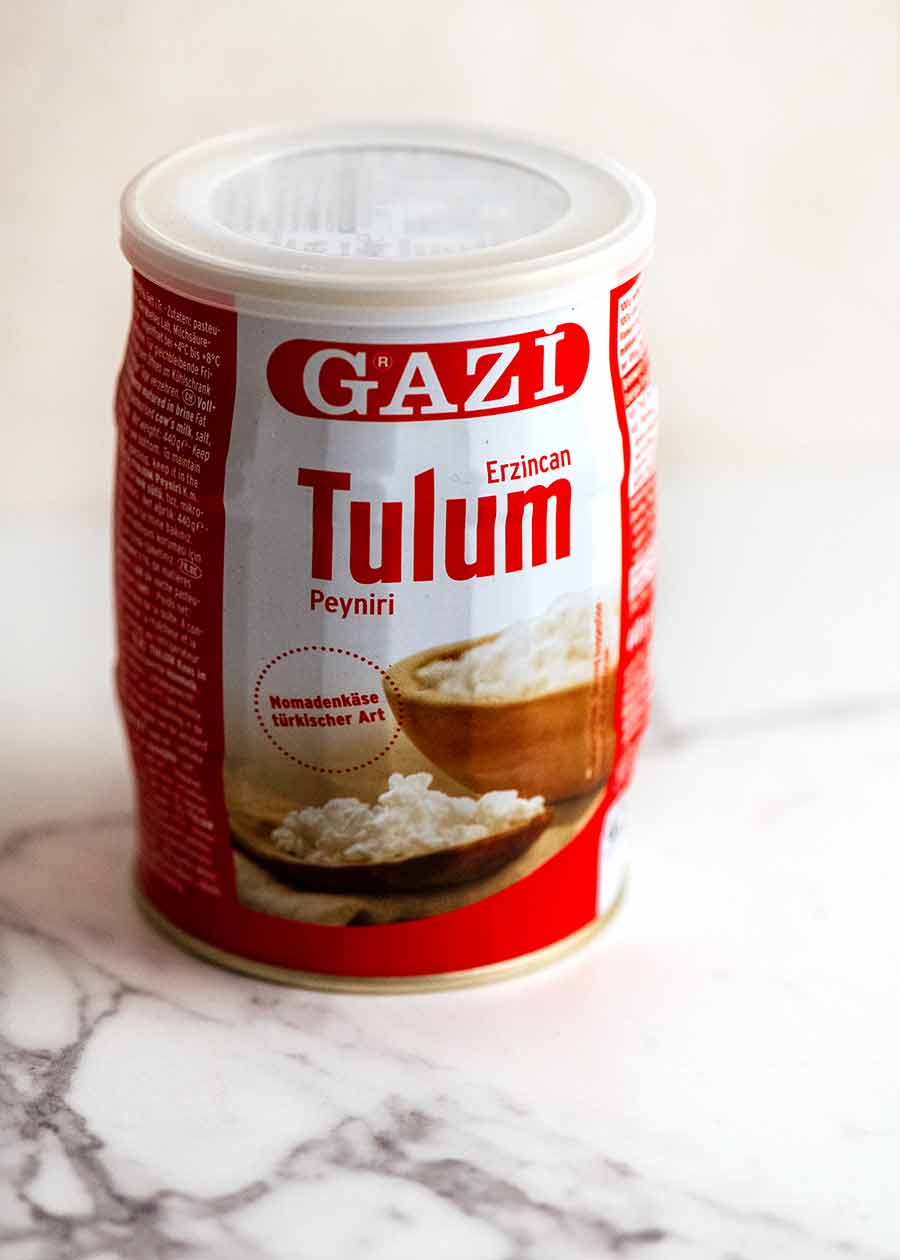
Tulum Turkish Cheese used for sprinkling the finished pide. 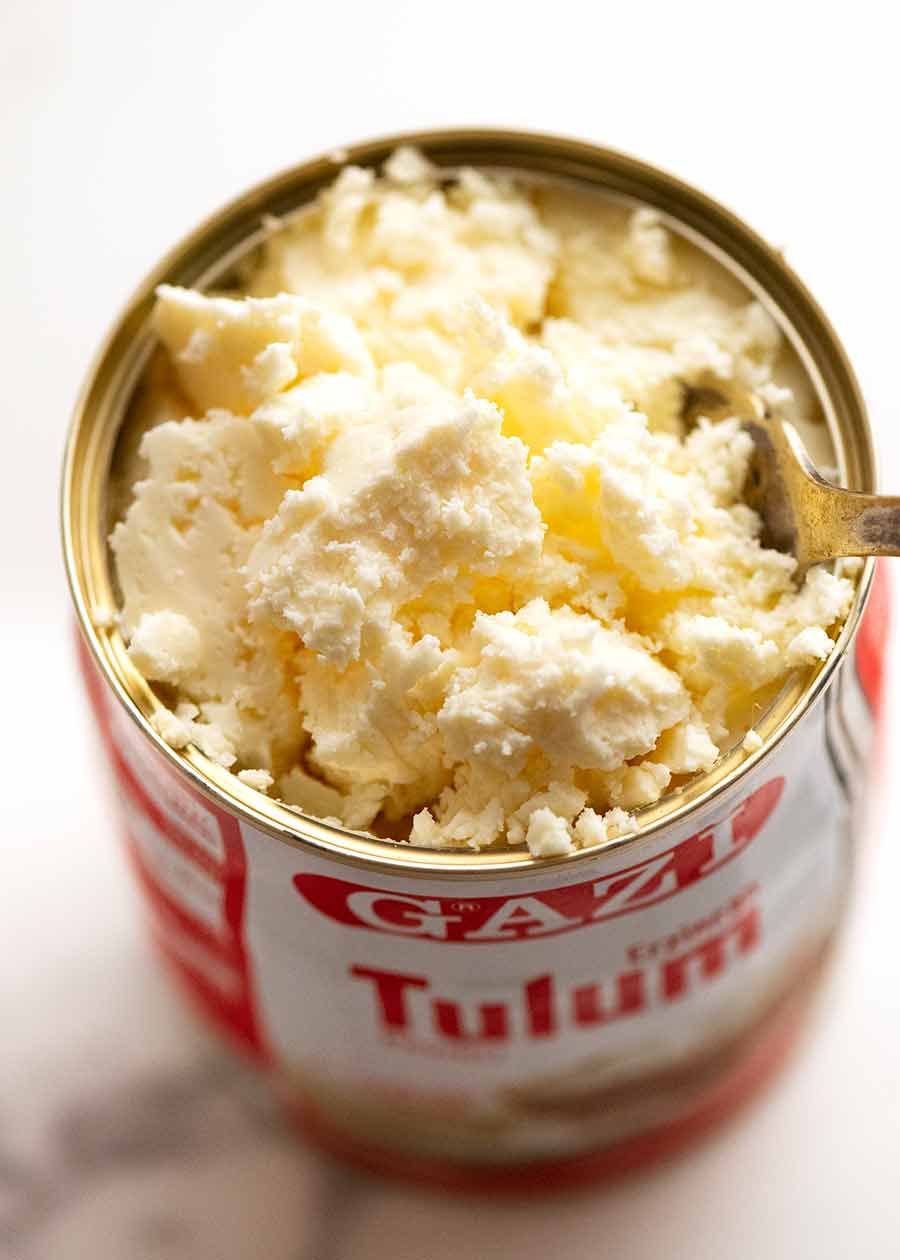
Looks and tastes like feta!
And now it’s your turn!
And with that, my friends, you are now armed with everything you need to know to make your very own homemade Turkish pide!!
I know this is a long post but it’s actually quite straightforward to make. Don’t be daunted – I covered 3 different topping options, whereas one batch of the recipe requires only one topping if you choose. As I mentioned earlier, I just wanted to ensure you have all the information you need to make Pide, even if you’re new to baking with yeast.
If you’re on the fence about whether to make this or not, well let me put it this way. Traditional Turkish Pide is few and far between here in Sydney. Even Turkish restaurants are a bit hit and miss, especially if they’re not made fresh. I have tried many in my time and while “researching” for this recipe! Too often the topping is disappointingly dry or worse still, skimpy. Or the bread is too yeasty (a common offence!). Or it’s too dry and too crispy, rather than pillowy soft and moist inside with just the right amount of crispiness on the outside.
I may be a trash-pide lover too but you can see I’m also fussy about my pide when I want to be! And so I created this homemade recipe, which ticks all my Pide boxes. And I’m confident it will yours too! – Nagi x
PS. This is fun food for sharing with family and friends. Assemble multiple Pide ready for baking, then bake them 2 at a time in the oven. Just keep them coming out, one after the other until your guests beg, “Stop!” 😂
Watch how to make it
Hungry for more? Subscribe to my newsletter and follow along on Facebook, Pinterest and Instagram for all of the latest updates.

Pide – Turkish Flat Bread / Pizza
Ingredients
Dough (Makes 2 pide):
- 1 tsp rapid rise / instant yeast (sub active dry yeast, Note 1)
- 1/2 tsp white sugar
- 2 tbsp + 2/3 cups very warm water , (~40℃ /104℉, Note 2)
- 2 cups bread flour (sub all purpose/plain flour, Note 3)
- 3/4 tsp salt
- 1 1/2 tsp olive oil
Pide Assembling:
- 150g / 5oz Turkish kasar cheese or mozzarella (Note 4)
- 1/2 tsp semolina , optional (Note 10)
- 1 Topping of choice (each makes enough for 2 pides)
- 1 egg (optional, Note 13)
- Sprinkling finishes of choice (listed below)
Spinach Topping:
- 2 tsp olive oil
- 1/2 onion , finely diced
- 280g / 10oz baby spinach
- 1/2 tsp cumin
- 1/2 tsp pepper
- 1/4 tsp salt (kosher / cooking salt)
Turkish Sausage Topping (Sujuk):
- 125g / 4oz Turkish sujuk sausage (sub chorizo, Note 5)
Lamb Topping:
- 1 tbsp olive oil
- 1/2 onion , finely diced
- 1 garlic cloves , finely minced
- 250g / 8oz lamb mince (or beef)
- 1 tsp tomato paste
- 1 tsp baharat spice mix (Note 6)
- 1/2 tsp cumin
- 1/8 tsp each salt and pepper
- 1/2 red capsicum / bell pepper , finely diced
- 1/2 tomato , finely chopped
- 1 tsp lemon juice
Sprinkling Finishes – Choose (Note 11):
- 4 tbsp Turkish tulum cheese or feta , crumbled (Note 7)
- Dried oregano
- Sesame seeds , toasted
- Sumac
- Fresh coriander/cilantro leaves
- Extra virgin olive oil
Instructions
Pide Dough:
- Bloom yeast: Mix yeast with 2 tbsp warm water and sugar in a small bowl. Cover with cling wrap, leave for 10 minutes until foamy.
- Make dough: Mix together flour and salt in a large bowl or stand mixer bowl. Add the yeast mixture, olive oil and remaining 2/3 cups water. Mix together with a wooden spoon. Once the flour is mostly incorporated, switch to your hands and bring it together into a dough.
- Knead: Sprinkle work surface with 1 tbsp flour, then knead for 8 to 10 minutes by hand OR 3 minutes on speed 6 of a stand mixer. Dough is kneaded enough when it's smooth and does not break when stretched – see photos video for before/after comparison. (Note 8)
- Rise 1: Shape into a ball. Smear inside of used bowl with a bit of olive oil, place dough inside. Cover with cling wrap and rise in warm place for 1.5 hours, or until doubled in size. (Note 9)
- Rise 2: Punch dough down to fully deflate, then divide into 2 equal pieces. Pull the sides down and tuck underneath so the top is smooth, underside is bunched up. Shape into ball and place on a lightly floured tray, smooth side up. Sprinkle surface with flour, then cover with damp tea towel. Rise 1 hour until doubled in size.
Assembling & Baking Pide:
- Preheat oven to 240°C/465°F (220°C fan). Place shelf on the top and middle.
- Roll: Roll dough out on a lightly floured surface into an oval shape 40cm/16" long and 20cm/8" wide (widest point).
- Prepare 2 trays: Sprinkle 1/4 tsp semolina on each tray, 40cm/16" long and 15cm/6" wide. (Note 10)
- Top Pide: Place a rolled out dough on the semolina. Sprinkle with cheese, then sprinkle chosen Topping evenly across the surface, leaving a 2cm / 4/5" border all around.
- Fold dough: Brush the ends with water. Pinch ends together to seal then fold the sides of the pide in.
- Bake: Bake 15 minutes, switching trays halfway, until the crust is golden.
- Egg option: Bake pide for 10 minutes, then crack the egg on top and return to oven for 5 minutes. This applies to all Pide – egg can be added for any of them!
- Top & Serve: Sprinkle with toppings of choice. (Note 11 for combos I used). Cut into 3cm / 1.3" slices and serve!
Spinach Topping:
- Heat oil in a skillet over medium heat. Cook onion for 3 minutes until translucent. Add spinach, cook until just wilted (add in batches if necessary). Stir in cumin, salt & pepper. Cool before using.
Turkish Sausage Topping:
- Roughly chop, then turn the sausage into mince (ground meat) by using a Nutribullet or food processor.
Lamb Topping:
- Heat oil in a skillet over medium high heat. Cook garlic and onion for 3 minutes until soft. Add lamb and cook until it changes from pink to brown. Add tomato paste, Baharat, cumin, salt, pepper and cook for 3 minutes.
- Add capsicum, tomato and lemon juice, then cook over medium heat until most of the liquid evaporates (a couple of minutes usually, though depends on juiciness of tomato). Cool before using.
Recipe Notes:
- 1 tsp paprika (not smoked)
- 1/2 tsp EACH ground cumin, coriander, cinnamon
- 1/4 tsp nutmeg
- 1/8 tsp EACH ground cloves, cardamom
- Spinach Pide – Tulum (feta), sesame seeds, extra virgin olive oil
- Turkish Sausage Pide – Tulum (feta), oregano, extra virgin olive oil
- Lamb Pide – Tulum (feta), sesame seeds, sumac, coriander.
Nutrition Information:
Takeaway favourites done right!
Life of Dozer
It was such a long shoot, he almost fell asleep under the shoot table waiting for a pide to fall on the floor! 😂





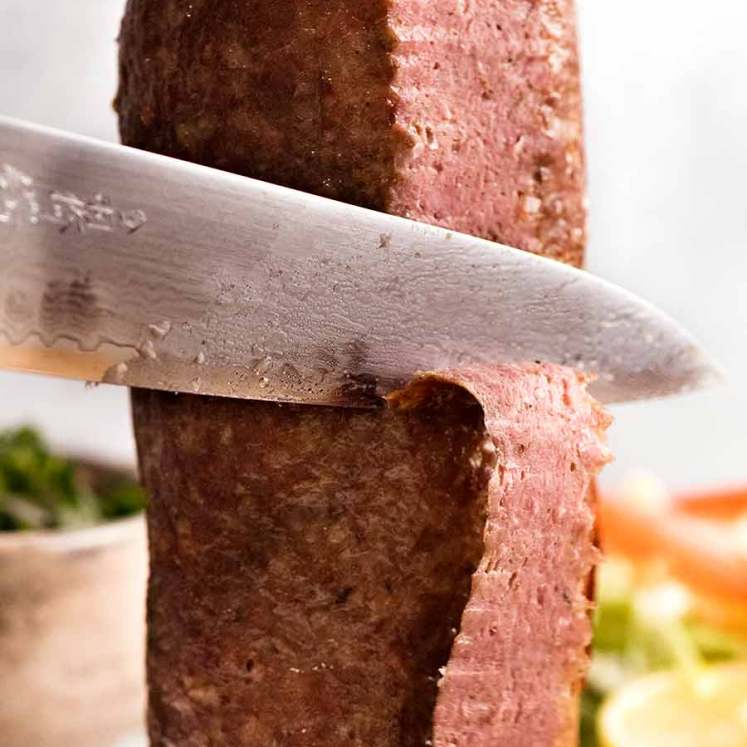







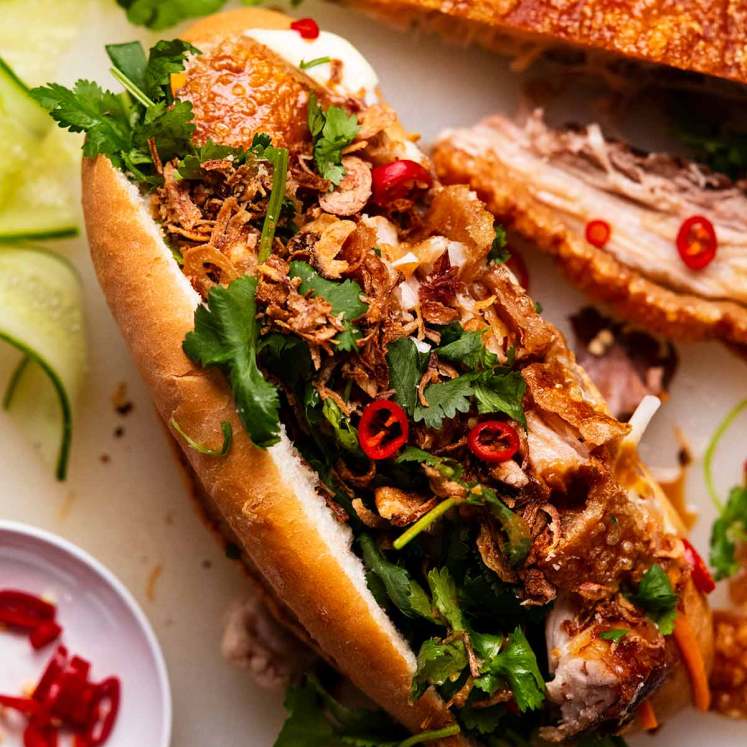

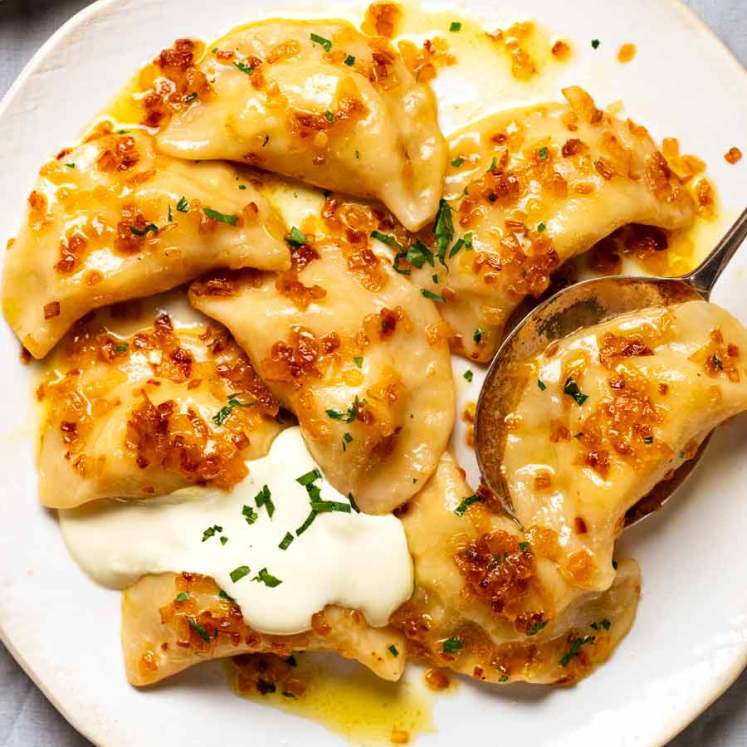
I made this for what has to be the 20th time today and accidentally added too much water making it a 77% hydration dough, rather than a 65% hydration dough and the result was sublime, the Pide was absolutely perfect. My husband and my father asked me what had changed because one of their favourite recipes was now even better. What a happy accident.😊 Naturally having a higher hydration the dough was a little tricker to handle but it wasn’t a big deal. I should mention that I always cook Pide on a baking stone. It was so yummy, and the mouthfeel was so good that couldn’t stop eating it, I normally eat half a Pide but I ate it all but one slice. 🤤
Hi Nagi, you’ve created a monster!
None of your recipes have failed me (apart from wrapping the bacon around the pork tenderloin – just didn’t look like your picture) and now everyone in my house wants me to cook every night.
I’m a homemade pizza freak and have it down to a fine art but… after making your Turkish Pide’s that’s all everyone asks for now when I ask them what they would like for dinner.
It’s all about the dough and getting it right, toppings are a personal thing.
Anyone making this recipe follow the instructions on making the dough, you can’t fail.
Thank you Nagi,
You’ve created a monster.
Amazing! We made these in the pizza oven and omg they are beautiful. Made the spinach and the lamb with feta, and made a few of our own flavours too. Such a great bread and the toppings are so delicious too!
My shaping was a complete fail! I made a spinach filling but added eggs and cottage cheese for a little extra protein. Will definitely try the other fillings in the future. The bread is so good!
Hi there, i made it tonight and it was delicious. But wondering if i read a couple of things wrong. I did the 4 quantity. In the instructions it says 390 ml water, but in the instructions it says to use 2 TB so 40ml then the remaining 2/3 cup- that doesn’t add up.
Also when doing the 2nd rise, in the printed instructions it says to prove for 1 hour, but in your photo instruction/step by step instructions it says 15 minutes. Can you please just clarify for me? Again, they were delicious and my family loved them.
This was sooo good! I have dearly missed late night Turkish pide since leaving Australia and now this will be a regular on the menu. I doubled the dough and next time might cut it into six to make slightly smaller ones easy for the kids to have their own. I did the spinach topping with egg (leftovers were breakfast, mmm) and then an Iskender kebap for the other. I can’t wait to try all sorts of toppings! Thanks for another delicious and easy recipe!
Thank you very much for this recipe! I was looking to make something different and interesting, and this was perfect! I adapted slightly to suit the ingredients at hand, but the flavours were perfect – I had beef, pepperoni, and spinach pides, spiced as your recipes, and they tasted perfect – just like from a fancy Turkish restaurant. So delicious!
What a great recipe website. Thanks.
I’d been wondering how “Pide – Turkish Flat Bread / Pizza” is made and came to your site. Its great and such interesting info.
Congratulations.
Hi Nagi,
We love the site it’s our ‘Go to’ place for recipes! Just want to cook Turkish bread for our Turkish friends. Is it possible to cook the dough without all the toppings? Would I fry or bake them?
Baking is the way to go.
Hi Nagi,
Just wondering if you think it’s possible to over-proof the dough in this recipe if I am making it all in one day? I am up to proof 2 (only 1 hour) and it’s only midday (try to be prepared!)
I’ve covered with a damp tea towel and glad wrap just in case, but do you think it’s worth refrigerating to slow down the proofing process?
Thanks! Emma
You can overproof any dough Emma if it’s too hot or it rises too quickly. If you are concerned then I would slow it down in the fridge. N x
Thanks Nagi! Will pop it in the fridge for a couple of hours to slow
WOW! That is a lot of information but it has ‘armed’ me with all the necessary info that I will need. Even though I haven’t yet made Pide as yet (but, believe me I will), I have gone ahead and given the rating of 5 stars because I know this recipe will be worth every one of those stars so a huge thankyou for that long post! PS: I have subscribed and I will definitely let you know how I go and hopefully post some pictures if I can 🙂
I deeply share this pide trash food love Nagi, and my late night Turkish take away exploits always involved a tub of hommus to dip the slices in after squeezing fresh lemon all over. Divine! Will be smashing into this with all my favourite toppings as you’ve stepped them out – thank you!
You just can’t go past them for late night snacking!!! N x
Yum! I did the lamb topping (used ground sausage though since I didn’t have ground lamb) and it was so good! Very different flavor but absolutely delicious! The dough was easy to make and it produced two well-sized pides! Would love to try other toppings as well. Definitely would recommend this!
Thank you Felishia! N x
Those pide are beyond delicious! The dough is perfectly crispy outside and fluffy inside. Paired it with the spinach filling…..and none are left (even though I doubled the amount). This will for sure go on a weekly rotation at my house
This has replaced pizza night at ours. The possible fillings, spices, and various flavourings with whatever is on hand are endless, and every time delicious.
Thanks! N x
Excellent, we made the spinach and the chorizo versions. Tasted just like the ones from the local Pide house. Would love advice on the best type of pan to use – I used what we had – the pizza stone (from cold) result was slightly too soggy, and the meat roasting pan slightly too brown.
Hi Heather…I have made it on a normal baking sheet. The darker the sheet, the more brown the base will get. Also use one that is slightly heavier weight if you have it…not a really thin cookie sheet. N x
These are awesome. I made all 3 flavours instead of pizza on a Friday night. The whole family devoured them. Thanks for another amazing recipe. We also loved your gozleme.
I have made this recipe twice and both times turned about delicious. I work with some Turkish people and when I showed them a picture of what I made they couldn’t believe how good it looked. People give it a go. It’s not hard and you will be truly rewarded with great tasting flavours.
Delicious! I couldn’t find ground lamb unless I drove 45 minutes, live in a small town, so I did ground turkey , with spinach , it was still very good. Next time I will drive the 45 minutes for lamb. Love everything from this site.
Nagi to the rescue again! Wasn’t sure what to cook. Had all ingredients on hand except the sausage so I subbed with an African boerewors sausage . Your recipes are divine thank you! I have all my family using your website now 🙂